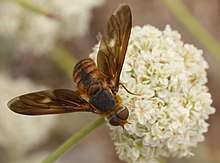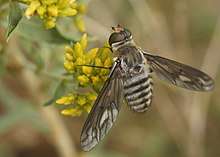Poecilanthrax
Poecilanthrax is a large, primarily Nearctic genus of flies belonging to the family Bombyliidae (bee-flies).
| Poecilanthrax | |
|---|---|
 | |
| Scientific classification | |
| Kingdom: | |
| Phylum: | |
| Class: | |
| Order: | |
| Family: | |
| Subfamily: | |
| Tribe: | |
| Genus: | Poecilanthrax Osten Sacken, 1886 |
| Type species | |
| Anthrax alcyon Say, 1825 | |
These are large to large robust flies with a body length of 8–14 mm. They have large elongate pictured wings, with 2 or 3 submarginal cells and no vein M2. The abdomen is moderately lengthened, with 7 visible tergites. The front tarsi are reduced, and the tibia smooth.[1] The larvae feed on the moth larva of members of the family Noctuidae. Adults feed on pollen.[1]

Poecilanthrax eremicus nectaring on California Buckwheat near the visitor center of Devil's Punchbowl, Pearblossom, California

Poecilanthrax apache in Sheldon National Antelope Refuge, Nevada, US
Species
- Poecilanthrax alcyon (Say, 1824) i c b
- Poecilanthrax alpha (Osten Sacken, 1877) i c g b
- Poecilanthrax apache Painter & Hall, 1960 i c g b
- Poecilanthrax arethusa (Osten Sacken, 1886) i c g b
- Poecilanthrax arizonensis Taber, 2008 c g
- Poecilanthrax autumnalis (Cole, 1917) i c g
- Poecilanthrax bicellata (Macquart, 1847) c g b
- Poecilanthrax brachypus Calderwood, 1995 c g
- Poecilanthrax californicus (Cole, 1917) i c g b
- Poecilanthrax colei Johnson and Johnson, 1957 i c g
- Poecilanthrax demogorgon (Walker, 1849) i c g
- Poecilanthrax effrenus (Coquillett, 1887) i c g b
- Poecilanthrax eremicus Painter & Hall, 1960 i c g b
- Poecilanthrax fasciatus Johnson & Johnson, 1957 i c g b
- Poecilanthrax flaviceps (Loew, 1869) c g
- Poecilanthrax fuliginosus (Loew, 1869) c b
- Poecilanthrax hyalinipennis Painter & Hall, 1960 i c g b
- Poecilanthrax ingens Johnson & Johnson, 1957 i c g b
- Poecilanthrax interruptus Painter & Hall, 1960 c g
- Poecilanthrax johnsonorum Painter and Hall, 1960 i c g
- Poecilanthrax litoralis Painter & Hall, 1960 i c g b
- Poecilanthrax loewi Evenhuis & Greathead, 1999 c g
- Poecilanthrax lucifer (Fabricius, 1775) i c g b
- Poecilanthrax macquarti Evenhuis & Greathead, 1999 c g
- Poecilanthrax marmoreus Johnson and Johnson, 1957 i c g
- Poecilanthrax mexicanus Painter, 1969 i c g
- Poecilanthrax moffitti Painter and Hall, 1960 i c g
- Poecilanthrax montanus Painter and Hall, 1960 i c g
- Poecilanthrax monticola Johnson & Johnson, 1957 c g b
- Poecilanthrax nigripennis (Cole, 1917) i c g b
- Poecilanthrax painteri Maughan, 1935 i c g
- Poecilanthrax pallidifrons Evenhuis, 1977 i c g
- Poecilanthrax pilosus (Cole, 1917) i c g
- Poecilanthrax poecilogaster (Osten Sacken, 1886b) c g b
- Poecilanthrax robustus Johnson and Johnson, 1957 i c g
- Poecilanthrax sackenii (Coquillett, 1887) c g b
- Poecilanthrax signatipennis (Cole, 1917) i c g
- Poecilanthrax tanbarkensis Painter and Hall, 1960 i c g
- Poecilanthrax tegminipennis (Say, 1824) i c g b
- Poecilanthrax varius Painter & Hall, 1960 i c g b
- Poecilanthrax vexativus Painter and Hall, 1960 i c g
- Poecilanthrax willistonii (Coquillett, 1887) i c b
- Poecilanthrax zionensis Johnson and Johnson, 1957 i c g[2][3]
Data sources: i = ITIS,[4] c = Catalogue of Life,[5] g = GBIF,[6] b = Bugguide.net[7]
gollark: Localized to a single computer, obviously.
gollark: AstroMan: The VFS does that.
gollark: Anyway. The ROM can't be edited as such, but you can kind of make it seem as if it contains files which it doesn't *actually* like potatOS does.
gollark: Not a feature now.
gollark: It Just wasn't Ever Contained.
References
- Hull, F.M. (1973). Bee flies of the world. The genera of the family Bombyliidae. Washington: Smithsonian Institution Press. pp. 687 pp. ISBN 0-87474-131-9.
- "World Catalog Family Bombyliidae Latreille (part 1 (Oligodraninae through Bombyliinae, p. 1-206)" (PDF). Bishop Museum. 1999. pp. 1–206. Retrieved 12 January 2009.
- "World Catalog Family Bombyliidae Latreille (part 1 (Oligodraninae through Bombyliinae, p. 1-206) - Revised Edition" (PDF). Bishop Museum. September 2003. pp. 1–206. Retrieved 12 January 2009.
- "Poecilanthrax Report". Integrated Taxonomic Information System. Retrieved 2018-05-04.
- "Browse Poecilanthrax". Catalogue of Life. Retrieved 2018-05-04.
- "Poecilanthrax". GBIF. Retrieved 2018-05-04.
- "Poecilanthrax Genus Information". BugGuide.net. Retrieved 2018-05-04.
This article is issued from Wikipedia. The text is licensed under Creative Commons - Attribution - Sharealike. Additional terms may apply for the media files.